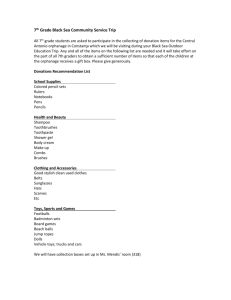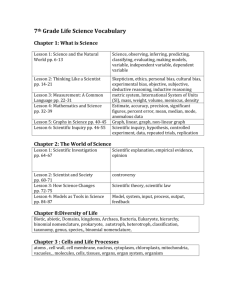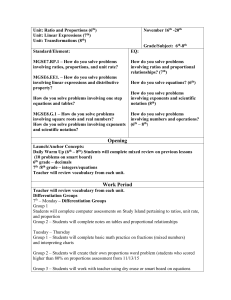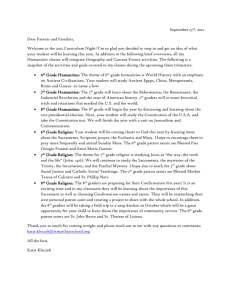7th Grade Mathematics - Orange Public Schools
advertisement
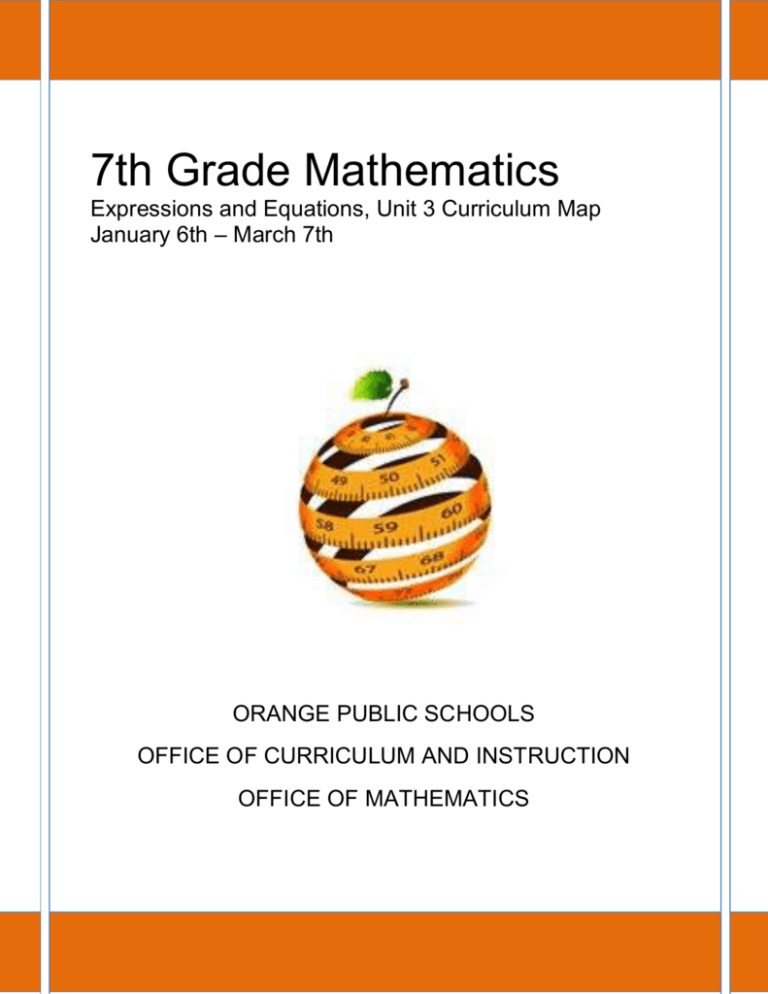
7th Grade Mathematics Expressions and Equations, Unit 3 Curriculum Map January 6th – March 7th ORANGE PUBLIC SCHOOLS OFFICE OF CURRICULUM AND INSTRUCTION OFFICE OF MATHEMATICS 7th Grade Unit 3 January 6th – March 7th Table of Contents I. Unit Overview p. 2 II. Important Dates and Calendar p. 3 III. Curriculum Guide p. 4 IV. Review Content Overview p. 5 V. Structure of the Modules p. 6 VI. Common Core Standards – Review p. 7 VII. Teaching Multiple Representations – Review Content p. 8 VIII. Common Core Standards Grade 7 – Major Work p. 9 IX. Connections to Mathematical Practices p. 10 X. Vocabulary p. 11 XI. Potential Misconceptions p. 12 XII. Teaching Multiple Representations Grade 7 – Major Work p. 13-14 XIII. Associated Illustrative Math Tasks p. 15 XIV. Assessment Check 1 p. 16 XV. Assessment Check 2 p. 17 XVI. Summative Tasks p. 18 XVII. Extensions and Sources p. 19 1 7th Grade Unit 3 January 6th – March 7th Unit Overview In this unit, students will …. develop a deeper understanding of numbers express different representations of rational numbers (e.g., fractions, decimals, and percent’s) solve multi-step equations and discuss the difference between equations and expressions Enduring Understandings Variables can be used to represent numbers in any type mathematical problem. Understand the difference in an expression and an equation. Write and solve multi-step equations including all rational numbers. 2 January 6th – March 7th 7th Grade Unit 3 Important Dates and Calendar Week of … 1/6-1/10 1/13-1/17 1/21-1/24 1/27-1/31 2/3-2/7 Monday Tuesday Wednesday Thursday Friday REVIEW MODULES No School Checkpoint 1/2 Day UNIT 3 NEW CONTENT 2/10-2/14 2/17-2/21 NO SCHOOL 2/24-2/28 3/34-3/7 UNIT 3 NEW CONTENT Assessment Week IMPORTANT DATES Monday, Jan 20th Friday, Jan 24th Friday, Jan 31st Week of Feb 17th Friday, March 14th Friday, March 21st MLK Day Checkpoint 2 Grades 6-7 1/2 Day VACATION Data Due Data Returned to Principals 3 January 6th – March 7th 7th Grade Unit 3 Curriculum Guide Activity Common Core Review Modules Common Core Standards 6.EE.3-6.EE.8 Estimated Time 12 days Checkpoint #2 (Friday, January 24th) Moving Straight Ahead Investigations 1-4 Assessment Check 1 SGO Standards 7.EE.1, 7.EE.3, 7.EE.4 1 day 12 days 7.EE.1, 7.EE.3 ½ day Common Core Investigations Investigation 2: Equivalent Expressions Miles to Kilometers Illustrative Mathematics Task 7.EE.1, 7.EE.2 4 days 7.EE.1 1 day Ticket to Ride Illustrative Mathematics Task 7.EE.2 1 day Shrinking Illustrative Mathematics Task 7.EE.3 1 day Assessment Check 2 7.EE.2 1/2 day Selected Review Based on Assessment Checks All Standards 1 day TOTAL DAYS 34-37 days (Depending on Assessment) Unit Assessment Week of 3/3 4 7th Grade Unit 3 January 6th – March 7th Review Content Overview Rationale As referenced in the PARCC Model Content Frameworks, students should build on previous 6th grade work with proportions, unit rates, and graphing in preparation for deeper learning and understanding of linear relationships. Students have been working with linear equations informally since kindergarten. Building a strong foundation in earlier Expressions and Equations standards will aid in student success in grade 7. Expressions and Equations questions constitute 25% of the possible points on the Grade 7 New Jersey Assessment of Skills and Knowledge. This unit plan incorporates review using the progressions of Expressions and Equations from grade 6 to grade 8. To review previous content, Common Core Modules were specially designed. These Modules were developed for use in grades 3 – 8 and Algebra I as response to the need for rich problem solving tasks that satisfy higher levels of cognitive demand. We took cues from the National Mathematics Advisory Panel’s Final Report (2008) in recognizing the mutually reinforcing benefits of conceptual understanding, procedural fluency, and automatic (i.e., quick and effortless) recall of facts.(p. xiv). The Modules contain a variety of well-selected items (offering a triad of conceptual, procedural, real world and mathematical problem solving). Students experience a steady diet of these types of problems throughout each of the Modules. In an effort to provide the District with mathematical content that is narrow, focused and deep, each Module is centered on the Critical Areas specified by the Common Core State Standards for Mathematics (CCSSM) and the Priority Areas denoted within the Partnership for Assessments of Readiness for College and Careers (PARCC) Framework. 5 7th Grade Unit 3 January 6th – March 7th Structure of the Modules The Modules embody 3 integrated frameworks that promote the development of conceptual and problems solving skills and computational fluency. The conceptual framework of the Modules builds from the concrete to the pictorial to the abstract (and the constant blending of each) to help students develop a deeper understanding of mathematics. The Modules also reference a multiple representations framework that encourages teachers to present content in multiple modalities to support flexible thinking. These frameworks go beyond concrete representation (i.e. manipulatives) to promote the realistic representation of concepts addressed in multiple settings. Lastly, the Modules embody a ‘gradual release’ framework that encourages teachers to progress from whole group to collaborative and finally to an independent practice format. OVERVIEW Each module begins with an overview. The overview provides the standards, goals, prerequisites, mathematical practices, and lesson progression. INTRODUCTORY TASKS The Introductory Tasks serve as the starting point for the referenced standard and are typically either diagnostic, prerequisite or anticipatory in nature. GUIDED PRACTICE Serves for additional teacher guided instruction for students who need the additional help. The tasks can be modeled with students. COLLABORATIVE PRACTICE Serve as small group, or partnered work. The work should promote student discourse, which allows students to make sense of problems and persevere in solving them (MP.1). Through teacher-facilitated, whole group discussion, students will have the opportunity to critique the reasoning of others (MP.3). JOURNAL QUESTIONS Provide the opportunity to individual, independent reflection and practice. This independent format encourages students to construct viable arguments (MP.3) and to reason abstractly/quantitatively (MP.2). HOMEWORK Can be used as additional in-class practice, Independent Practice, etc. This work should be reviewed and discussed. Procedural fluencies are reinforced within this section. GOLDEN PROBLEM The Golden Problem is a performance task that reflects an amalgamation of the skills addressed within the Module. The Golden Problem assesses the student’s ability to apply the skills learned in a new and non-routine context. More than one-step; problems usually require intermediate values before arriving at a solution (contextual applications). In the US, we see one step problems that require either recall or routine application of an algorithm. 6 7th Grade Unit 3 January 6th – March 7th Common Core Standards 6.EE.3 6.EE.4 6.EE.5 6.EE.6 6.EE.7 6.EE.8 PREREQUISITE CONTENT Apply the properties of operations to generate equivalent expressions. For example, apply the distributive property to the expression 3 (2 + x) to produce the equivalent expression 6 + 3x; apply the distributive property to the expression 24x + 18y to produce the equivalent expression 6 (4x + 3y); apply properties of operations to y + y + y to produce the equivalent expression 3y. Identify when two expressions are equivalent (i.e., when the two expressions name the same number regardless of which value is substituted into them). For example, the expressions y + y + y and 3y are equivalent because they name the same number regardless of which number y stands for. Understand solving an equation or inequality as a process of answering a question: which values from a specified set, if any, make the equation or inequality true? Use substitution to determine whether a given number in a specified set makes an equation or inequality true. Use variables to represent numbers and write expressions when solving a realworld or mathematical problem; understand that a variable can represent an unknown number, or, depending on the purpose at hand, any number in a specified set. Solve real-world and mathematical problems by writing and solving equations of the form x + p = q and px = q for cases in which p, q and x are all nonnegative rational numbers. Write an inequality of the form x > c or x < c to represent a constraint or condition in a real-world or mathematical problem. Recognize that inequalities of the form x > c or x < c have infinitely many solutions; represent solutions of such inequalities on number line diagrams. 7 7th Grade Unit 3 January 6th – March 7th Teaching to Multiple Representations – Review Content CONCRETE REPRESENTATIONS Algebra Tiles PICTORIAL REPRESENTATIONS Graphic Organizers i.e. input/output charts, tables, etc. Pan Balance ABSTRACT REPRESENTATIONS Order of Operations Properties of Addition and Multiplication Standard algorithms for addition, subtraction, multiplication, and division 8 7th Grade Unit 3 January 6th – March 7th Common Core Standards Grade 7 – Major Work 7.EE.1 (SLO 1) 7.EE.2 (SLO 2) 7.EE.3 (SLO 3, SLO 4) GRADE 7 CONTENT Apply properties of operations as strategies to add, subtract, factor, and expand linear expressions with rational coefficients. Understand that rewriting an expression in different forms in a problem context can shed light on the problem and how the quantities in it are related. For example, a + 0.05a = 1.05a means that “increase by 5%” is the same as “multiply by 1.05.” Solve multi-step real-life and mathematical problems posed with positive and negative rational numbers in any form (whole numbers, fractions, and decimals), using tools strategically. Apply properties of operations to calculate with numbers in any form; convert between forms as appropriate; and assess the reasonableness of answers using mental computation and estimation strategies. For example: If a woman making $25 an hour gets a 10% raise, she will make an additional 1/10 of her salary an hour, or $2.50, for a new salary of $27.50. If you want to place a towel bar 9 3/4 inches long in the center of a door that is 27 1/2 inches wide, you will need to place the bar about 9 inches from each edge; this estimate can be used as a check on the exact computation. CALCULATOR NOT ALLOWED CALCULATOR NOT ALLOWED CALCULATOR ALLOWED 9 7th Grade Unit 3 January 6th – March 7th Connections to the Mathematical Practices 1 2 3 4 5 6 7 8 Make sense of problems and persevere in solving them - Students solve real world problems through the application of algebraic concepts. - Students seek the meaning of a problem and look for efficient ways to represent and solve it. They may check their thinking by asking themselves, “What is the most efficient way to solve the problem?”, “Does this make sense?”, and “Can I solve the problem in a different way?” Reason abstractly and quantitatively - Students demonstrate quantitative reasoning by representing and solving real world situations using visuals, equations, inequalities and linear relationships into real world situations. Construct viable arguments and critique the reasoning of others - Students will discuss the differences among expressions, equations and inequalities using appropriate terminology and tools/visuals. - Students will apply their knowledge of equations and inequalities to support their arguments and critique the reasoning of others while supporting their own position. Model with mathematics - Students will model an understanding of expressions, equations, inequalities, and graphs using tools such as algebra tiles/blocks, counters, protractors, compasses, and visuals to represent real world situations. Use appropriate tools strategically - Students demonstrate their ability to select and use the most appropriate tool (pencil/paper, manipulatives, calculators, protractors, etc.) while rewriting/evaluating/analyzing expressions, solving and representing and analyzing linear relationships. Attend to precision - Students demonstrate precision by correctly using numbers, variables and symbols to represent expressions, equations and linear relationships, and correctly label units. - Students use precision in calculation by checking the reasonableness of their answers and making adjustments accordingly. - Students will use appropriate algebraic language to describe the steps in rewriting expressions and solving equations. Look for and make use of structure - Students routinely seek patterns or structures to model and solve problems. - Students apply properties to generate equivalent expressions (i.e. 6 + 2x = 2 (3 + x) by distributive property) and solve equations (i.e. 2c + 3 = 15, 2c = 12 by subtraction property of equality; c=6 by division property of equality). Look for and express regularity in repeated reasoning - In grade 7, students use repeated reasoning to understand algorithms and make generalizations about patterns. - During multiple opportunities to solve and model problems, they may notice that a/b ÷ c/d = ad/bc and construct other examples and models that confirm their generalization. They extend their thinking to include complex fractions and rational numbers. 10 7th Grade Unit 3 January 6th – March 7th Vocabulary Term Algebraic Expression Definition An expression consisting of at least one variable and also consisting of numbers and operations Coefficient The number part of a term that includes a variable. For example, 3 is the coefficient of the term 3x. Constant A quantity having a fixed value that does not change or vary, such as a number. For example, 5 is the constant of x + 5. Equation A mathematical sentence formed by setting two expressions equal. Inequality A mathematical sentence formed by placing inequality symbol between two expressions A number, a variable, or product and a number and variable Term Numerical Expression Variable An expression consisting of numbers and operations A symbol, usually a letter, which is used to represent one or more numbers 11 7th Grade Unit 3 January 6th – March 7th Potential Student Misconceptions Students believe variables always represent unknowns or numbers that can vary. In truth, variables represent different things in different situations. Sometimes, there is one solution to make an equation true. In expressions (not an equality statement, a variable can represent many values). A flexible conceptualization of variables will help students see algebra as a language to be used and mastered – not as a collection of meaningless rules and procedures. Students have trouble interpreting the negative sign simultaneously as “minus” and “negative.” Students may also struggle with operations on negative numbers, having learned procedural rules such as “two negatives cancel each other out.” Memorizing the rules for operations, without sufficient understanding, only undermines students’ abilities to make sense of more advanced concepts. Students interpret the equal sign as “the answer is.” This misconception arises from students’ early experiences with the equal sign in computation problems. When collecting like terms, students fail to relate their knowledge of the addition of constants to the collection of variables. Students may think that percentages cannot be greater than 100, not realizing that one whole equals 100%. When adding and subtracting fractions with unlike denominators, students may have trouble rewriting the fractions as equivalent fractions with a common denominator. This process is especially challenging when the fractions include variables. Students have difficulty identifying the common denominators and then rewriting the fraction or problem. Use models to explain what a denominator represents to help students understand the process. 12 7th Grade Unit 3 January 6th – March 7th Teaching Multiple Representations Grade 7 – Major Work CONCRETE REPRESENTATIONS Bar Model Algebra Tiles PICTORIAL REPRESENTATIONS Tabular Representation Graphing 13 7th Grade Unit 3 January 6th – March 7th ABSTRACT REPRESENTATIONS Simplifying Expressions/Combining Like Terms Generating an Equation a+.05a=1.05a Properties of Operations: Commutative Associative Distributive 14 January 6th – March 7th 7th Grade Unit 3 Associated Illustrative Math Tasks 7.EE.1 Miles to Kilometers The students in Mr. Sanchez's class are converting distances measured in miles to kilometers. To estimate the number of kilometers, Abby takes the number of miles, doubles it, then subtracts 20% of the result. Renato first divides the number of miles by 5, then multiplies the result by 8. a. Write an algebraic expression for each method. b. Use your answer to part (a) to decide if the two methods give the same answer. 7.EE.2 Ticket to Ride Malia is at an amusement park. She bought 14 tickets, and each ride requires 2 tickets. a. Write an expression that gives the number of tickets Malia has left in terms of x, the number of rides she has already gone on. Find at least one other expression that is equivalent to it. b. 14−2x represent the number of tickets Malia has left after she has gone on x rides. How can each of the following numbers and expressions be interpreted in terms of tickets and rides? 14 −2 2x c. 2(7−x) also represent the number of tickets Malia has left after she has gone on x rides. How can each of the following numbers and expressions be interpreted in terms of tickets and rides? 7 (7−x) 2 7.EE.3 Shrinking When working on a report for class, Catrina read that a woman over the age of 40 can lose approximately 0.06 centimeters of height per year. a. Catrina's aunt Nancy is 40 years old and is 5 feet 7 inches tall. Assuming her height decreases at this rate after the age of 40, about how tall will she be at age 65? (Remember that 1 inch = 2.54 centimeters.) b. Catrina's 90-year-old grandmother is 5 feet 1 inch tall. Assuming her grandmother's height has also decreased at this rate, about how tall was she at age 40? Explain your reasoning. 15 7th Grade Unit 3 January 6th – March 7th Assessment Checks Assessment Check 1 1. Which expression represents the sum of (2x – 5y) and (x + y)? A. 3x – 4y B. 3x – 6y C. x – 4y D. x – 6y 2. In the following equation, a and b are both integers. a(3x – 8) = b – 18x 3. David bought a computer that was 20% off the regular price of $1,080. If an 8% sales tax was added to the cost of the computer, what was the total price David paid for it? A. $302.40 B. $864.00 C. $933.12 D. $1,382.40 4. A framed picture 24-inches wide and 28-inches high is shown in the diagram below. The picture will be hung on a wall where the distance from the floor to ceiling is 8 feet. The center of the picture must be 5 ¼ feet from the floor. Determine the distance from the ceiling to the top of the picture frame. Show your work. 16 7th Grade Unit 3 January 6th – March 7th Assessment Check 2 1. Leo bought a used car for x dollars. One year later, the value of the car was 0.88x. Which expression is another way to describe the change in the value of the car? A. 0.12% decrease B. 0.88% decrease C. 12% decrease D. 88% decrease 2. All books in a store are being discounted by 30%. Part A Let x represent the regular price of any book in the store. Write an expression that can be used to find the sale price of any book in the store. Expression: Part B Jerome bought a book on sale at the store. The sale price of the book was $8.96. Write and solve an equation to determine the regular price of the book to the nearest cent. Equation: Regular price of book: 17 7th Grade Unit 3 January 6th – March 7th Summative Assessment Resources Summative Assessment Resources Gotham City Taxis (7.EE.3, 7.RP.3) The taxi fare in Gotham City is $2.40 for the first 12 mile and additional mileage charged at the rate $0.20 for each additional 0.1 mile. You plan to give the driver a $2 tip. How many miles can you ride for $10? Anna in DC (6.EE.3, 6.EE.7, 7.RP.3, 7.EE.3, 6.RP.3) Anna enjoys dinner at a restaurant in Washington, D.C., where the sales tax on meals is 10%. She leaves a 15% tip on the price of her meal before the sales tax is added, and the tax is calculated on the pre-tip amount. She spends a total of $27.50 for dinner. What is the cost of her dinner without tax or tip? 18 7th Grade Unit 3 January 6th – March 7th Extensions and Sources Online Resources http://www.illustrativemathematics.org/standards/k8 - Performance tasks, scoring guides https://www.khanacademy.org/math/ - Interactive, tracks student points, objective descriptive videos, allows for hints http://www.doe.k12.de.us/assessment/files/Math_Grade_7.pdf - Common Core aligned assessment questions, including Next Generation Assessment Prototypes http://www.learnzillion.com - Videos organized by Common Core Standard presented with visual representations and student friendly language https://www.georgiastandards.org/Common-Core/Pages/Math-6-8.aspx - Common Core assessment resources, tasks designed for students with special needs http://www.parcconline.org/sites/parcc/files/PARCCMCFMathematicsGRADE8_Nov2012V3_FIN AL.pdf - PARCC Model Content Frameworks Grade 8 http://commoncoretools.files.wordpress.com/2011/04/ccss_progression_ee_2011_04_25.pdf - Progressions of Expressions and Equations from grades 6-8 19


